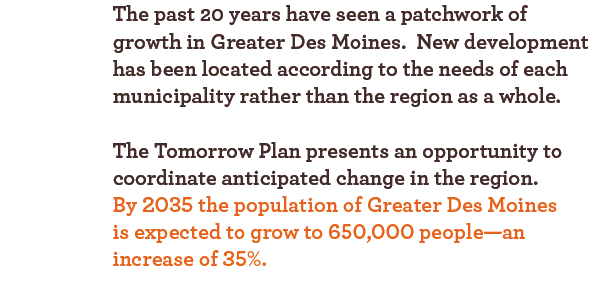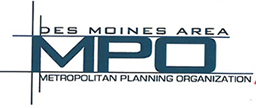
The Tomorrow Plan creates a vibrant, enduring future for greater Des Moines. Historically, the many issues facing the region have been tackled by a variety of agencies and organizations. This planning effort brings together these many groups as well as people who live, work and play in the area to work together toward a shared future.
PROCESS
Phase 1: Project Initiation (July 2011 – September 2011)
The first phase lays the foundation for the project, sets up a public participation process, defines an outreach strategy, launches the website, and gathers early public input through a series of meetings and events.
Phase 2: Regional Assessment (July 2011 – December 2011)
The second phase assembles existing plans and data as the basis for understanding our likely future if current trends continue. It also identifies critical issues for the region and measures this “business as usual” scenario using a range of tools.
Phase 3: Regional Vision for Sustainability (December 2011 – July 2012)
The third phase tests alternative scenarios for regional growth. This includes evaluating the various scenarios to understand the tradeoffs among different development patterns and eventually identifying a preferred future direction for sustainable development of the region.
Phase 4: Regional Sustainability Framework (June 2010 – November 2012)
The fourth phase further develops the preferred direction identified in Phase 3. This includes creating a set of plan components that address the key systems within the greater Des Moines region. A number of implementation goals and strategies will be identified for each component.
Phase 5: Sustainability Report and Implementation (September 2012 – February 2013)
The final phase of work focuses on compiling the plan components into a complete regional plan for sustainable development. An accompanying action plan will identify priorities for implementation and recommend changes within both the public and private sectors in order to achieve the regional vision set out in the plan.
OBJECTIVES
The project leadership has outlined the following objectives for the regional plan:
- Creation of regional transportation, housing, water, and air quality plans that are deeply aligned and tied to local comprehensive land use and capital investment plans
- Aligned federal planning and investment resources that mirror the local and regional strategies for achieving sustainable communities
- Increased participation and decision-making in developing and implementing a long-range vision for the region by populations traditionally marginalized in public planning processes
- Reduced social and economic disparities for the low-income, minority communities, and other disadvantaged populations within the target region
- Decreased per capita Vehicle Miles Traveled (VMT) and transportation-related emissions for the region
- Decreased overall combined housing and transportation costs per household
- Increased share of residential and commercial construction on under-used infill development sites that encourage revitalization, while minimizing displacement in neighborhoods with significant disadvantaged populations
- Increased proportion of low and very low-income households within a 30 minute transit commute to major employment centers
- Increased number of mixed use, mixed income, diverse neighborhoods, with pedestrian and/or transit access to services, good jobs, good schools, parks, and trails
- Improved public health outcomes that result from creating safer, more walkable neighborhoods
- Increased use of compact development as a tool for regional planning to accommodate population growth, to utilize infrastructure efficiently, and to preserve productive agricultural land and natural areas for environmental and recreational purposes
- Decreased hazardous environmental threats due to regional increases in the rate and frequency of flooding and erosion, and to compromised water quality
- Enhanced regional competitiveness through coordinated regional economic development and amenity planning
- Increased use of compact development as a tool for regional planning to accommodate population growth, to utilize infrastructure efficiently, and to preserve agricultural land and natural areas for environmental and recreational purposes
- Identification of unique challenges/hurdles to achieving the foregoing, contemplated outcomes





